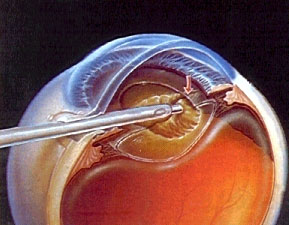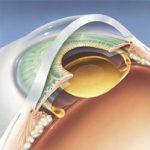CATARACT SURGERY
Cataracts are one of the most frequent causes of vision loss. Fortunately, however, this can be recuperated. It is an ocular pathology which can affect people of all ages , but is more common in those over the age of 65, although it can appear in younger people. Inside the eye, all human beings have a natural lens called the crystalline lens, which enables us to see well and also to read. Over time, and in some specific cases, this lens becomes opaque and changes color (in some cases it can acquire a pearlescent white color).

A cataract, therefore, is an opacity of the crystalline lens, which diminishes vision progressively and which can take years to appear. When this opacity increases, it produces a great deal of discomfort and there is a decrease in the quality and clarity of vision. Cataracts should be considered a normal process in the life of all human beings , which cause more discomfort to some people than others , depending on the activity or profession they have. There exist some symptoms which normally appear during the evolution of a cataract.

Symptoms
The most common symptom is a decrease in vision, although initially the patient does not notice that they are developing a cataract.
Other symptoms , although less frequent,are blurred vision, occasionally double vision, bad night vision and paradoxically, it being easier to read without glasses, when previously these were necessary. As the cataract increases, vision decreases and if it remains untreated, it may even lead to blindness.
There exist other causes which can produce cataracts, general diseases such as diabetes, rheumatic illnesses etc.., the consumption of medication, traumatic and congenital diseases
When should cataracts be operated on ?
Although cataracts are not an ophthalmological emergency, they should be operated on when our ophthalmologist recommends it, contrary to the old, widespread opinion that one should wait till the cataract completely closes off our vision. One should not wait until the ‘’CATARACT MATURES’’, because by doing that the surgical risks increase. The treatment of cataracts is always surgical. Modern-day ophthalmological techniques allow us to operate on cataracts with very sophisticated equipment and local anesthetic. The main surgical technique used by the team at H.O.I. is PHACOEMULSIFICATION, which eliminates the cataract by means of ultrasound, following that with the implantation of an intraocular lens with the diopters that the patient requires (See below for the different types of intraocular lenses). This lens is inserted into the eye through a small incision. Using this technique, vision improves rapidly, without the necessity of hospitalizing the patient, which means that at no point are they out of their usual surroundings and that they can return home immediately after the intervention.
There is also another type of cataract, the CONGENITAL CATARACT. This type of cataract requires a special mention because it affects children in very early life. Congenital cataracts must be operated on as soon as they are diagnosed, to prevent lazy eyes or Amblyopia developing.By doing this, the child’s vision is rehabilitated and they manage to have useful vision.
A patient who has been operated on for cataracts, once one or two months have passed, will need to have a new graduation of glasses because their eyesight will have improved considerably. The intraocular lens which we implant after extracting the crystalline lens can be monofocal, multifocal and/ or toric.


